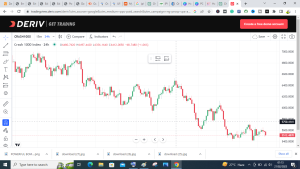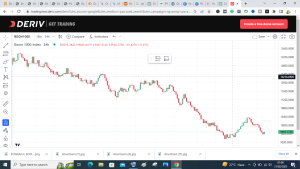are you searching on how to trade Boom and Crash indices? then this article is for you. Here I will guild you step by step on how you make profit
As the world of trading evolves, new and exciting opportunities are emerging. One such opportunity is the trading of boom and crash indices which enable one to make profit.
These fast-paced financial instruments allow traders to capitalize on short-term market movements and potentially make significant profits.
In this guide, we will explore everything you need to know about how to trade boom and crash indices successfully just keep reading.
Section 1: Understanding The Boom and Crash Indices
H1: What are Boom and Crash Indices?
Boom and crash indices are financial instruments that track the movement of markets in a fast-paced manner and also being generated by computer.
They are offered by various brokers and are based on the concept of trading the volatility of a market. These indices offer a high-risk, high-reward potential for traders looking to make quick profits.
H2: How Does Boom and Crash Indices Work ?
Boom and crash indices work by tracking the price movement of a specific market in a given time.
Traders can place bets on the direction of the market, either up or down as well. The price of these indices fluctuates rapidly, offering a unique opportunity for traders to capitalize on short-term market movements moves.
H3: Benefits of Trading Boom and Crash Indices For 2023?
Trading boom and crash indices offer several benefits to traders, including:
High-profit potential
Short-term trading opportunities that profit
No need for extensive market research
Accessible to both beginner and advanced traders
Section 2: Getting Started with Trading Boom and Crash Indices
H1: Choosing a Broker
To trade boom and crash indices, you will need to choose a Deriv or binary broker that offers these financial instruments. When selecting a broker, consider the following factors
Regulation and safety
Trading platform
Commissions and fees
Educational resources
H2: Setting Up a Trading Account
Once you have selected a Deriv broker, you will need to set up a trading account. This process typically involves providing personal information and funding your account.
Most brokers offer a variety of funding options, including credit cards, bank transfers, and e-wallets.
H3: Understanding Trading Strategies
To trade boom and crash indices successfully, you will need to develop effective trading strategies. Some popular strategies include:
Scalping: taking advantage of short-term market movements
Trend following: identifying and trading in the direction of a trend
Range trading: identifying support and resistance levels and trading within those boundaries
Section 3: Best Practices for Trading Boom and Crash Indices
H1: Risk Management
Trading boom and crash indices can be highly volatile and carry a significant amount of risk.
It is essential to implement effective risk management strategies, such as setting stop-loss orders and managing position sizes.
H2: Utilizing Technical Analysis
Technical analysis is a popular method used to analyze market trends and identify potential trading opportunities. By analyzing charts and identifying patterns, traders can make informed trading decisions.
H3: Staying Informed
To be a successful trader of boom and crash indices, it is essential to stay informed about market trends and news. This can be done by following financial news outlets, subscribing to market analysis newsletters, and utilizing social media platforms to stay up to date.
Section 4: Frequently Asked Questions
FAQ 1: Can I trade boom and crash indices on my mobile device?
Yes, many brokers offer mobile trading apps that allow traders to access the market from their mobile devices.
FAQ 2: How much capital do I need to start trading boom and crash indices?
The amount of capital required to start trading boom and crash indices will depend on the broker and
trading platform you choose. Some brokers may have minimum deposit requirements, while others may allow traders to start with as little as $10.
FAQ 3: Are boom and crash indices regulated?
Yes, many brokers that offer boom and crash indices are regulated by financial authorities you can also make your own research


